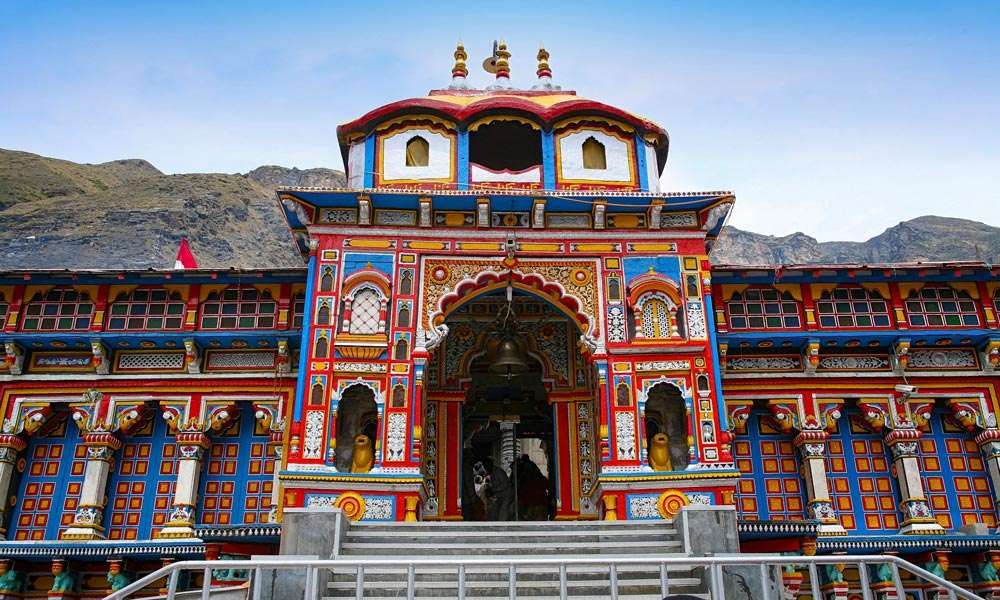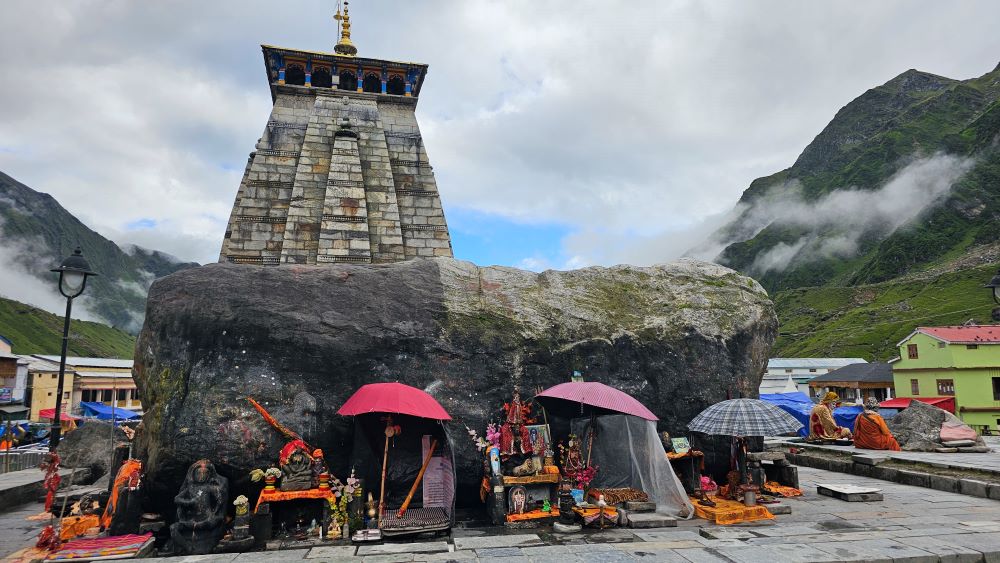
BADRINATH TEMPLE

DO DHAM YATRA – AN OVERVIEW
Do Dham Yatra – (Kedarnath & Badrinath )
The Do Dham Yatra is a revered and sacred pilgrimage in Hinduism, comprising journey to two sacred destinations nestled in the majestic Himalayas. This spiritual journey to the Do Dhams typically involves visits to Badrinath and Kedarnath, two of the holiest sites in India. Badrinath temple is dedicated to Lord Vishnu, and Kedarnath temple is dedicated to Lord Shiva. These two temples of the four dhams hold immense significance in Hindu mythology and religious beliefs.
Do Dham Yatra begins with pilgrims first visiting the site of Badrinath , situated on the banks of the Alaknanda River. Here, devotees seek blessings at the Badrinath Temple, a towering edifice dating back centuries, believed to be constructed by the 8th-century philosopher Adi Shankaracharya. The temple’s striking architecture and serene surroundings create an atmosphere of spiritual tranquility.
From Badrinath, pilgrims embark on a challenging yet spiritually enriching trek or journey to Kedarnath, located amidst the breathtaking Garhwal Himalayas. The Kedarnath Temple, near the mandakini river, is a stone edifice of unknown date. It is not certain who built it and when, located at an altitude of 3,583 meters (11,755 feet), holds sway over devotees with its simplistic yet profound ambiance. Legend has it that the temple survived the ordeals of time, a testament to Lord Shiva’s enduring presence.
Kedarnath is also part of Panchkedar, supposed to represent the hump of Lord Shiva. Kedarnath temple is flanked by the Kedarnath peak and the Kedarnath dome , subpeak of the main peak.
Throughout the Do Dham Yatra, devotees engage in prayers, rituals, and offerings, seeking redemption, enlightenment, and divine blessings and ultimate goal of Moksha. The journey isn’t merely physical; it’s a transformative experience, symbolizing the arduous yet rewarding path to spiritual awakening amidst the awe-inspiring grandeur of the Himalayas.
BADRINATH YATRA
Do Dham Yatra typically begins with the Badrinath Yatra, it is a revered pilgrimage in Hinduism, journey to the sacred Badrinath Temple dedicated to Lord Vishnu. The temple is located in the Garhwal hills of Chamoli district of Uttarakhand, alongside the ferocious river Alaknanda, this journey holds immense significance for devotees seeking spiritual bliss. The temple is a stone edifice , said to have built by the sage Adi Shankracharya. The Nar Parbat mountain is located opposite to the temple, while the Narayana Parbat is located behind the Neelkanth peak.It is open for six months every year (between the end of April on the onset period of char dham yatra and the beginning of November), because of extreme weather conditions in the Himalayan region.
Legend has it that Badrinath was the abode of Lord Vishnu during the Satya Yuga, an age of truth and righteousness. The temple’s origin is dedicated to the legendary sage Adi Shankaracharya, who discovered the deity of Badrinath in the Alaknanda River and established the temple around it.
Upon reaching the temple, devotees are greeted by the striking architecture and serene ambiance, enhancing the aura. Many pilgrims consider it a requirement to bathe in the springs of Tapt Kund – a group of hot springs before visiting the temple
Pilgrims engage in rituals, prayers, and offerings, seeking blessings for prosperity, well-being, and spiritual enlightenment. The Badrinath Yatra is a transformative experience that purifies the soul and deepens one’s faith.
The temple is one of the holy places where the Hindus offer prayers to ancestors with the help of the priests. Devotees visit the temple to worship in front of the image of Badrinath in the sanctum. The main shrine houses the Shaligram (black stone) deity of Badrinarayana, which is located in a gold canopy under a Badri Tree
KEDARNATH YATRA
The temple is located on the Garhwal Himalayan range , with Kedarnath peak and its subpeak kedarnath dome in the backgroud, flanked by the Mandakini river, in the state of Uttarakhand, India. Due to extreme weather conditions, the temple is open to the general public only between the months of April (Akshaya Tritiya) and November (Kartik Purnima, the autumn full moon). During the winters, the (deity) of the temple is carried down to Ukhimath to be worshipped for the next six months. Kedarnath is seen as the form of Shiva, the ‘Lord of Kedarkhand’, the historical name of the region. The journey to Kedarnath begins with reverence and anticipation as pilgrims embark on a spiritual quest to seek blessings and divine grace. Many pilgrims start their journey from Gaurikund, the base camp for the trek to Kedarnath, which is about 16 kilometers away.
Although the trek is arduous and physically challenging as the ascend is steep and the region witnesses snow quite often due to high altitude, the sight of the holy temple makes the effort worth it and makes it spritually rewarding. The ascend is through scenic valleys, dense forests, and gurgling rivers, providing pilgrims with an opportunity to immerse themselves in nature’s beauty while contemplating the divine.
As pilgrims ascend higher, the air gets thinner, and the terrain becomes more rugged, testing their endurance and determination. Along the way, they encounter several small temples, natural hot springs, and resting places, where they can replenish their energy and offer prayers.
Upon reaching Kedarnath, pilgrims are greeted by the majestic Kedarnath Temple, nestled amidst snow-capped peaks and surrounded by pristine wilderness. Its a stone edifice and is of the twelve Jyotirlingas and the most significant part of Panch kedar pilgrimage.
Devotees spend their time in Kedarnath engaging in prayers, rituals, and meditation, seeking solace, enlightenment, and blessings from Lord Shiva. The atmosphere resonates with chants and hymns, creating a blissful sense of devotion and reverence.
Kedarnath Temple has a fascinating story in Hindu mythology. It’s believed that after the great war of Mahabharata, the Pandavas wanted to seek forgiveness from Lord Shiva for the bloodshed. However, Lord Shiva didn’t want to forgive them easily and turned into a bull to hide. When the Pandavas found the bull, it dived into the ground, leaving behind its back part at Kedarnath. The hump is believed to be located at Kedarnath, while other parts of the bull appeared at other places, forming the Panch Kedar. Thus, Kedarnath Temple is considered one of the holiest places where Lord Shiva is worshipped to cleanse sins and seek blessings for spiritual growth and enlightenment.
Kedarnath also finds mention in the Skanda Purana ( 7th-8th century), which contains a story describing the origin of the Ganges river. The text names Kedara (Kedarnath) as the place where Shiva released the holy water from his matted hair.
Thus, Kedarnath Temple is considered one of the holiest places where Lord Shiva is worshipped to cleanse sins and seek blessings for spiritual growth and enlightenment.

DO DHAM YATRA- KEDARNATH & BADRINATH JI YATRA ITINERARY (5N/6-D)
Day 1: Arrival in Rishikesh
– Start your Do Dham Yatra from Rishikesh, known as the Gateway to the Himalayas.
– Spend the day exploring the saint city, visit the famous Ganga Aarti and soak in the spiritual vibes of The Rishikesh. Dinner and overnight stay in Hotel.
Day 2: Rishikesh to Sonprayag (Drive 210 kms , 8/9 hours)
– Morning wakeup early and Begin your Do Dham Yatra from Rishikesh along the Ganga up to Devprayag. At Devprayag Bhagirathi and Alaknanda River meets and become Ganga. Devprayag is also known as birth place of Ganga. After seeing Devprayag drive further to Rudraprayag. Rudraprayag is second holy confluence which is meeting point of Alaknanda and Mandakini River.
– Enjoy the scenic drive through mountains, valleys, and rivers.
– Reach Sonprayag and rest for the night, preparing for the Kedarnath trek ahead. Dinner and overnight stay in hotel.
Day 3: Sonprayag – Gaurikund (6 km by local taxi & Kedarnath ji (Trek 19 kms, 6/7 hours)
– Start your trek to Kedarnath, the abode of Lord Shiva.
– Kedarnath Trek mostly goes through picturesque landscapes, lush forests, and magnificent mountains and waterfalls.
– After reaching Kedarnath, visit the holy temple and be enchanted by its spiritual aura.
– Spend the night in Kedarnath, surrounded by the tranquil beauty of the Himalayas. Dinner and overnight stat in Hotel / Tent.
Day 4: Kedarnath to Gaurikund – Sonprayag – Joshimath (Trek down 19 kms and drive 180 kms)
– Descend from Kedarnath and head towards Joshimath, a scenic town en route to Badrinath.
– Enjoy the mesmerizing views of the mountains and the Alaknanda River.
– Reach Joshimath and explore the town while immersing yourself in its serene atmosphere.
– Dinner and Overnight stay in Joshimath.
Day 5: Joshimath to Badrinath (45 kms , 2/3 Hrs drive)
– Embark on the final leg of your journey to Badrinath, one of the Char Dham pilgrimage sites.
– Witness the blissful confluence of Alaknanda and Saraswati rivers at the only Brahma Kapal in India.
– Explore the sacred Badrinath Temple and embrace the spiritual energy around.
– After an awe-inspiring day, rest in Badrinath for the night.
Day 6: Badrinath to Rishikesh (300 kms , 10/12 Hrs drive)
– Bid farewell to the enchanting Himalayas and start your return journey to Rishikesh.
– Reflect upon the memories and spirituality gained throughout this divine journey.
– Arrive in Rishikesh and take some time to rejuvenate by the holy Ganges. Drop at hotel.
– Conclude the trip with a peaceful heart and memories to last a lifetime.
